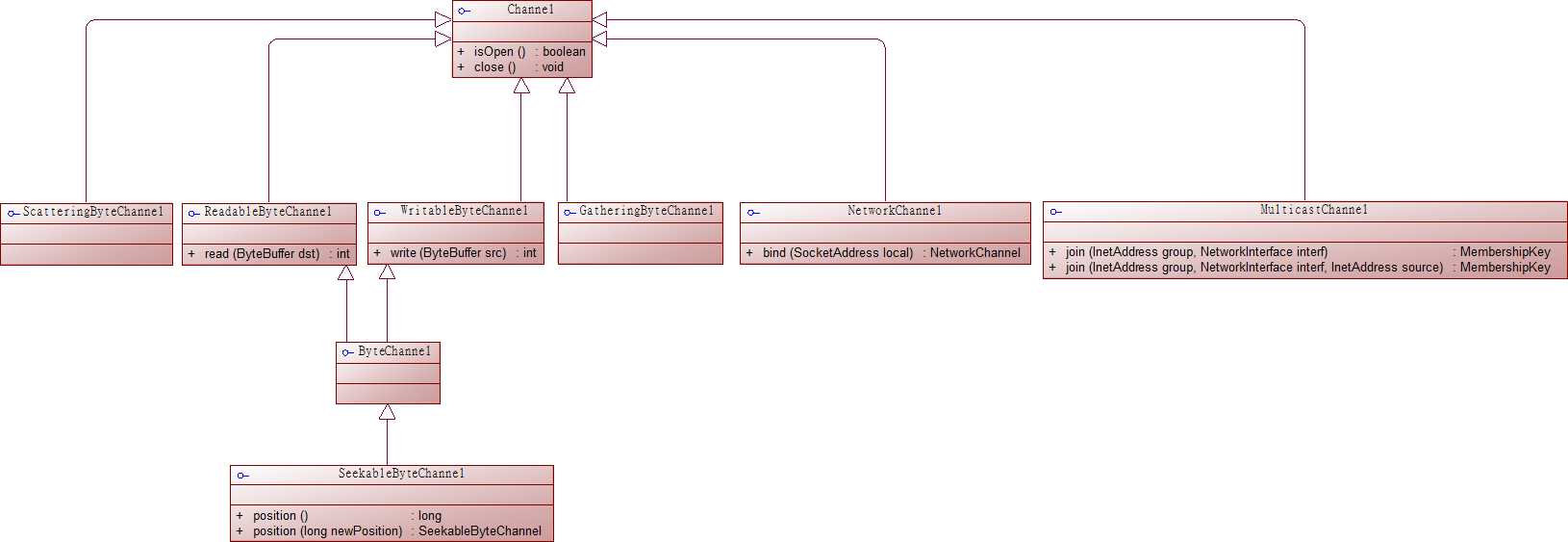标签:
Java 一直到 JDK 1.3 為止,都是使用 java.io 下的類別進行 I/O 的處理,對這有興趣的鄉民,可以參考「Java I/O」,那是我 13 年前整理的 ... XD。JDK 1.4 之後提供了 NIO,到了 JDK 1.7 又加上些新的功能,稱為 NIO.2,這些類別都被放在 java.nio 下,一般來說,使用 java.nio 類別操作檔案系統,會比使用 java.io 效率來的高且方便。
在進入主題前,各位不妨先看一下我之前整理的「Working with the Path Class」及「Metadata File Attributes」,這算是進入主題的前菜,這篇開始要說明怎麼開檔、讀檔、寫檔。
不管是要讀檔或寫檔,第一個步驟總得要開檔,java.nio 提供了以下的開檔方式:
底下是一個最典型的範例:
1 package idv.steven.nio2.metadata; 2 3 import java.io.IOException; 4 import java.nio.channels.ReadableByteChannel; 5 import java.nio.file.Files; 6 import java.nio.file.Path; 7 import java.nio.file.Paths; 8 import java.nio.file.StandardOpenOption; 9 10 public class NIO2File { 11 public static void main(String[] args) throws IOException { 12 Path path = Paths.get("C:/Java/poi-3.11/NOTICE"); 13 ReadableByteChannel channel = Files.newByteChannel(path, StandardOpenOption.READ); 14 //... 15 } 16 }
在 java.io 中,I/O 都是在串流 (stream) 中操作,到了 java.nio 都改為渠道 (channel),上面的程式是開啟一個讀取的檔案,所有開檔模式都定義在 StandOpenOption 這個自定型別中。如果要開啟一個寫入的檔案,第 13 行可能就改為如下:
WritableByteChannel channel = Files.newByteChannel(path, new OpenOption[] {StandardOpenOption.CREATE, StandardOpenOption.WRITE});
寫檔時不能只有 WRITE 這個參數,還要再加入如何 CREATE、CREATE_NEW 等參數,所有參數放在一個 OpenOption 陣列裡。
java.nio 定義了那些 channel ? 如下類別圖所示:

上圖只列出常用的介面及其 method,要了解詳細的類別繼承關係,請看 JDK Doc。操作檔案時,最常用的就是 ReadableByteChannel、WritableByteChannel 及 SeekableByteChannel,前兩者顧名思義,是分別用在讀檔及寫檔,第三個是同時可用在讀與寫的渠道,且可以在讀寫過程裡移動檔案指標。至於 NetworkChannel 和 MulticastChannel 是用在網路的 TCP 和 UDP 傳輸上,會另外說明。
在 java.nio 中定義了渠道取代 java.io 中的 stream,同時渠道操作的物件也不是 byte[]、char[]… 改成 java.nio 自行定義的 ByteBuffer、CharBuffer 等類別,最常用的是 ByteBuffer,關於 ByteBuffer 的說明,請看「ByteBuffer 指標說明」,在繼續往下看之前,請務必先了解 ByteBuffer。
1 package idv.steven.nio2.metadata; 2 3 import java.io.IOException; 4 import java.nio.ByteBuffer; 5 import java.nio.channels.ReadableByteChannel; 6 import java.nio.file.Files; 7 import java.nio.file.Path; 8 import java.nio.file.Paths; 9 import java.nio.file.StandardOpenOption; 10 11 public class NIO2File { 12 public static void main(String[] args) throws IOException { 13 Path path = Paths.get("C:/Java/poi-3.11/NOTICE"); 14 ReadableByteChannel channel = Files.newByteChannel(path, StandardOpenOption.READ); 15 16 ByteBuffer buffer = ByteBuffer.allocate(1024); 17 18 while (channel.read(buffer) > 0) { 19 System.out.println(new String(buffer.array())); 20 buffer.flip(); 21 } 22 23 channel.close(); 24 } 25 }
上面的程式,於 18 行每次讀取 1024 個 byte,直到檔尾為止,讀取後放入 buffer 中,在 19 行將讀取的內容輸出,讀完後當然要記得關檔 (23行)。
1 package idv.steven.nio2.metadata; 2 3 import java.io.IOException; 4 import java.nio.ByteBuffer; 5 import java.nio.channels.ReadableByteChannel; 6 import java.nio.channels.WritableByteChannel; 7 import java.nio.file.Files; 8 import java.nio.file.OpenOption; 9 import java.nio.file.Path; 10 import java.nio.file.Paths; 11 import java.nio.file.StandardOpenOption; 12 13 public class NIO2File { 14 public static void main(String[] args) throws IOException { 15 Path path = Paths.get("C:/Java/poi-3.11/NOTICE"); 16 ReadableByteChannel channel = Files.newByteChannel(path, StandardOpenOption.READ); 17 18 Path pathTo = Paths.get("C:/Java/poi-3.11/NOTICE.txt"); 19 WritableByteChannel channelTo = Files.newByteChannel(pathTo, 20 new OpenOption[] {StandardOpenOption.CREATE, StandardOpenOption.WRITE}); 21 22 ByteBuffer buffer = ByteBuffer.allocate(1024); 23 while ((channel.read(buffer)) > 0) { 24 buffer.flip(); 25 channelTo.write(buffer); 26 buffer.flip(); 27 } 28 29 channel.close(); 30 channelTo.close(); 31 } 32 }
這個程式只是將上一個程式擴充,將由 NOTICE 讀出的內容,寫入 NOTICE.txt 檔裡,在 19~20 行開啟一個寫入的檔案,於 24~26 行將讀到的內容寫入指定的檔案。
标签:
原文地址:http://www.cnblogs.com/stevwn/p/4659131.html